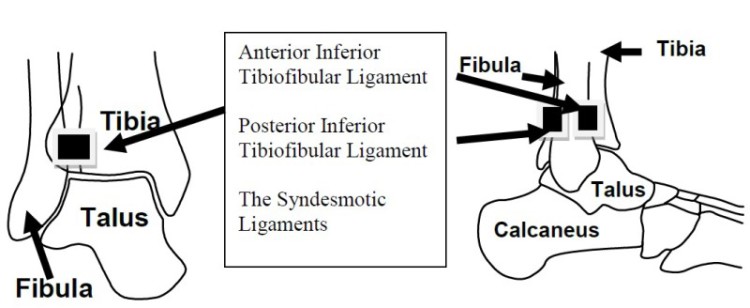High ankle sprains occur from twisting injuries to a fixed foot. They are common and vary in degree of severity. Grade I sprains involve only partial injury to the ligaments and are treated with protected weight bearing using a boot and early physical therapy. Some Grade II and all Grade III sprains that involve damage to more than one set of ligaments are unstable and will require surgery.
Bone fractures can also occur during a high energy ankle sprain. These fractures can occur to the bones that attach to the ankle ligaments or to the fibula. Oftentimes theses fractures are unstable and require surgery to address. Surgery corrects acute deformity, improves function, decreases risks of post-traumatic arthritis and speeds up your return to work and sports. To learn more about what occurs during surgery to address a severe high ankle sprain or one that presents with a fracture, keep reading!
Have you suffered a significant high ankle sprain or a high energy ankle fracture?
If so, let Dr. Silverman help.
For more information about surgery for unstable high ankle sprains, keep reading.

What Happens Before High Ankle Sprain Surgery?
The surgical center will give you specific instructions for how to prepare in the days and weeks leading up to surgery. The day of surgery you will receive regional anesthesia known as a popliteal nerve block. This is a procedure performed by the anesthesiologist prior to surgery. You will be placed on your stomach and a small needle will inject Novacaine-like medication around the nerve in your leg. This gives complete pain relief that lasts for 12 to 36 hours. Patients report extraordinary satisfaction with this type of anesthesia. You will be given sedatives during the surgery. Some people require general anesthesia. All patients receive antibiotics just before surgery to help prevent infection.
What Happens During High Ankle Sprain Surgery?
A tourniquet will be placed around your calf. Incisions are strategically placed. The fractured bones are put back together and plates, screws, or wires are used to fix the bones in place. Ligaments and tendons are repaired if needed. X-Rays taken during the surgery confirm the correction. Finally, the wounds are closed with staples and sutures.
What Happens After High Ankle Sprain Surgery?
You will be permitted to leave the post-anesthesia center once your anesthesiologist is satisfied that you have recovered. Patients with more severe injuries require an inpatient stay. During this recovery time your family member may take your prescription to the nearest pharmacy. You will be given crutches. Take your narcotic pain control medications during this early post-operative period. Post operative pain is much easier to control with prevention. Call to schedule your post-operative visit for two weeks after surgery when you feel able.
Unstable High Ankle Sprain General Recovery Timeline
This timeline is a general guideline. Your post-operative course may vary.
| Elevation | 23 hours / day for 3 days; swelling may last several months. |
| Motion | Move your toes when the block resolves. This will decrease pain and swelling, and improve healing. Begin ankle motion at 2 weeks. |
| Walking | Weight bearing can begin with Dr. Silverman’s permission at 4 weeks in the fracture brace or cast if you are given permission. Once the fracture heals you may wean out of the brace but, this varies depending on fracture. |
| Bathing | Keep cast dry. Use a DryPro. There are no restrictions after the cast is removed. |
| Pain Control | Expect to use strong narcotics for the first 3-5 days. Wean off as soon as you are comfortable using Tylenol |
| Work | Return depends on specific demands. It is safe to return to sedentary work at 10 days post-op. Return to heavy labor will take at least 3 months |
| Driving | Patients with left foot surgery may drive an automatic transmission. Patients with right foot surgery must drive with their left foot. This takes practice and doesn’t come easily |
Routine Clinic Visits
| 2 weeks | X-Ray, cast and staple removal. Apply a fracture brace or a new cast. |
| 6 weeks | X-Ray. This is the earliest time of bone healing to permit time out of boot and begin physical therapy. The time to return for your next visit varies significantly. |
| 3-4 months | If at any time during your post-operative period you notice any drainage or foul odor from your incision, a temperature of more than 100.4 degrees and/or increased swelling or tenderness, you should contact our office. |
| ********** | Return for recheck. Strength improves over the next year. Minimal feelings of discomfort may linger, your overall comfort level improves over a year. |
For more helpful tips, check out these rehab exercise videos that will help you recover, or reach out to Dr. Silverman for more information!